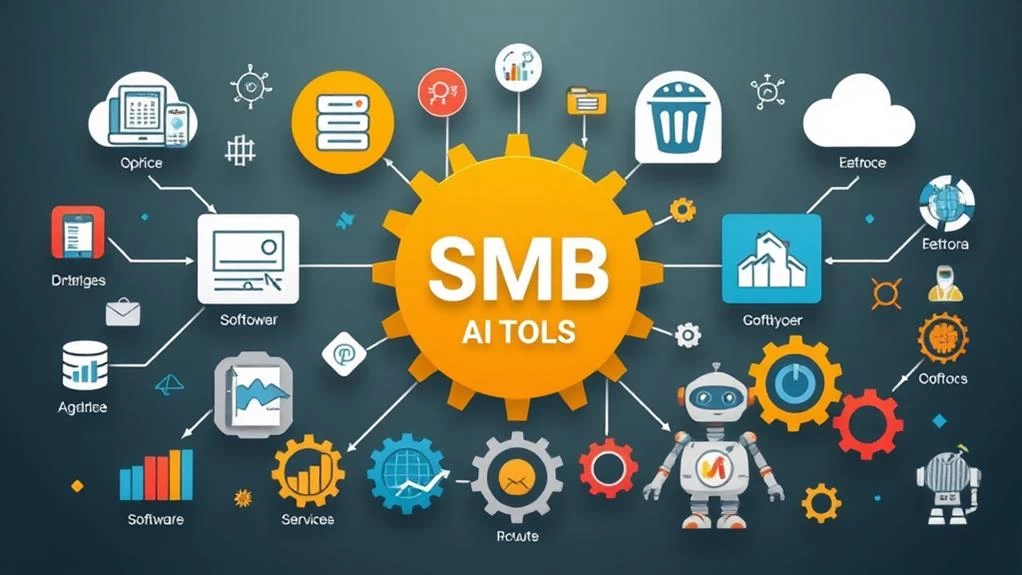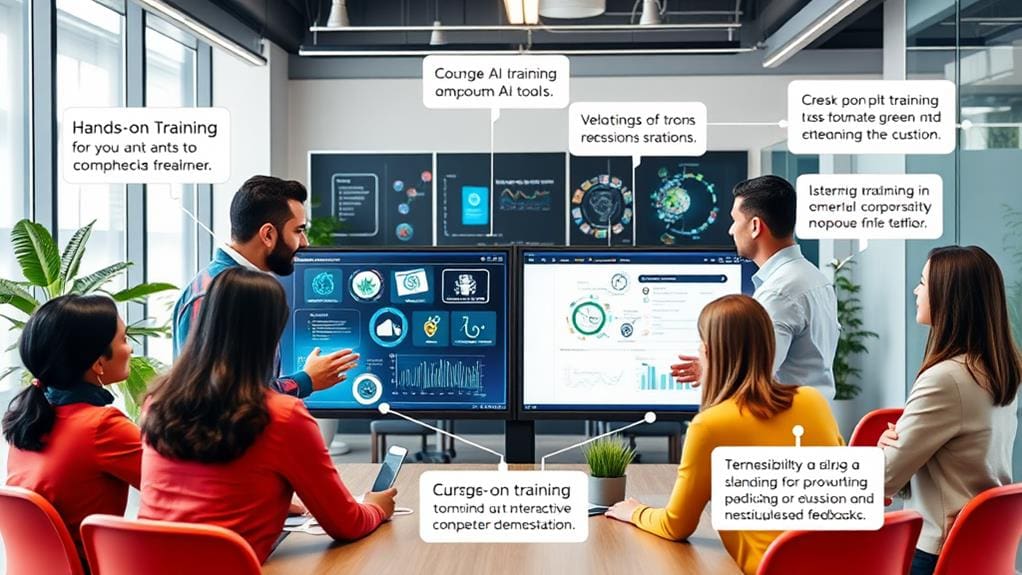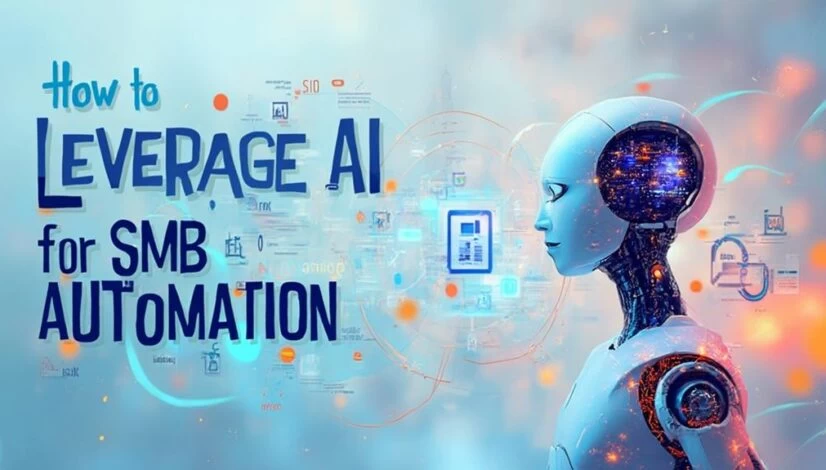How to Leverage AI for SMB Process Automation
To leverage AI for process automation in small and medium-sized businesses (SMBs), first identify repetitive tasks suitable for automation. Use workflow mapping to pinpoint inefficiencies and align AI tools with business needs. Implement systematic integration strategies to guarantee smooth shifts with legacy systems. Thorough training programs for employees will promote effective utilization of AI insights. Establish clear KPIs to measure success and ROI, while addressing security concerns around data privacy. Embrace modular solutions for scalability and iterative improvement. Exploring these foundational elements will reveal additional strategies to maximize AI's impact on your business operations.
Key Takeaways
- Identify repetitive and bottleneck tasks through workflow mapping to select processes suitable for AI automation, enhancing overall efficiency.
- Choose AI tools that align with your specific business needs, focusing on integration capabilities, scalability, and security features.
- Implement comprehensive training programs to equip your team with skills to interpret AI-driven insights and foster a continuous learning culture.
- Establish clear KPIs to measure success, analyzing cost savings and time efficiency to inform future investments in automation solutions.
- Prioritize data privacy and robust security measures, including user authentication and regular vulnerability assessments, to protect sensitive information.
Understanding AI in Business

Recognizing the transformative potential of artificial intelligence (AI) in business processes, organizations increasingly leverage advanced algorithms and machine learning techniques to enhance operational efficiency and decision-making. This adoption of AI is driving significant process optimization, enabling companies to analyze vast amounts of data with unprecedented speed and accuracy.
However, the incorporation of AI brings with it critical considerations, particularly concerning AI ethics, data privacy, and algorithm bias. As organizations design innovation strategies that encompass AI, they must prioritize user experience while adhering to robust AI governance frameworks that mitigate risks associated with these technologies.
Ensuring that machine learning models are trained on unbiased data sets is essential to avoid perpetuating existing societal inequalities. Implementing strong data privacy measures further protects consumer information, fostering trust and collaboration between businesses and their customers.
Technology adoption is not merely about integrating new tools but also renewing decision-making paradigms. Businesses must equip their teams with the skills necessary to interpret AI-driven insights, facilitating informed judgments that enhance strategic initiatives.
As AI becomes increasingly embedded in organizational processes, the emphasis on creating transparent and accountable methodologies is paramount.
Identifying Automatable Processes
To maximize the benefits of AI in business processes, organizations must first identify which tasks are suitable for automation. This involves a systematic approach to process selection and task prioritization, where repetitive tasks that frequently contribute to manual bottlenecks are targeted for automation. A thorough analysis of automation feasibility is vital; it guarantees that the processes identified can be effectively entrained with AI technologies.
Workflow mapping is an essential technique that allows businesses to visualize their processes, identifying points of inefficiency and potential bottlenecks. Engaging employee input in this phase is invaluable, as those on the front lines often possess insights into the practical challenges associated with current workflows. This collaborative approach enhances the accuracy of the automation assessment.
Furthermore, a robust technology assessment should be conducted to evaluate existing tools and platforms against the specific requirements of the processes mapped. Organizations must also consider integration challenges, which may arise as AI technologies are implemented alongside traditional systems. Understanding these potential obstacles allows for more informed decision-making, reducing disruption during the shift to automated workflows.
The potential benefits of identifying and automating the right processes extend beyond efficiency gains. They include improved accuracy, enhanced employee satisfaction by eliminating tedious tasks, and the freedom to reallocate resources towards higher-value activities.
Fundamentally, a meticulous approach to process identification lays the groundwork for a successful AI-driven automation strategy.
Choosing the Right Tools

Selecting the appropriate tools for process automation requires a thorough analysis of the specific business needs to guarantee alignment with strategic objectives.
Additionally, evaluating software features against these identified needs will facilitate the effective implementation of AI solutions that enhance operational efficiency.
A systematic approach in this selection process is critical for maximizing the return on investment and achieving desired outcomes.
Identify Business Needs
In the competitive landscape of small and medium-sized businesses (SMBs), identifying specific business needs is critical for optimizing operational efficiency through automation. A practical approach begins with collecting customer feedback and analyzing operational bottlenecks. Understanding these pain points enables businesses to prioritize which areas require immediate attention, resulting in significant improvements in responsiveness and service quality.
Conducting a thorough workflow analysis is essential; this involves mapping out current employee tasks and resource allocation to pinpoint inefficiencies. By employing process mapping techniques, businesses can visualize the interconnected elements of their operations, allowing for a more nuanced understanding of how automation can enhance productivity.
Incorporating stakeholder input throughout this assessment phase guarantees that diverse perspectives are considered, ultimately leading to informed decision-making. This collaborative approach fosters a culture of inclusivity, aligning the automation strategy with the organization's broader goals and enabling a more effective implementation process.
Evaluate Software Features
Choosing the appropriate software tools for automation requires a detailed evaluation of features to confirm they align with the identified business needs. Conducting a robust feature comparison among potential solutions is imperative, as it allows organizations to discern the functionalities that will maximize efficiency.
Key features to assess include integration capabilities, scalability, ease of use, and support responsiveness. User experience (UX) plays a pivotal role in this evaluation; software designed with intuitive interfaces reduces training time and enhances employee adoption rates. A seamless UX can catalyze productivity by minimizing operational friction.
Data-driven businesses should leverage analytics tools that provide real-time insights into performance metrics, empowering decision-makers to optimize processes continuously. Furthermore, security features are paramount, particularly for SMBs handling sensitive information.
Evaluate encryption standards, compliance with regulations, and overall data protection policies to mitigate risks. Finally, consider the vendor's track record and community support—user reviews can offer invaluable insights into real-world application and satisfaction.
A thorough evaluation of software features confirms that companies invest wisely in automation solutions, fostering growth and operational freedom.
Implementing AI Solutions
Implementing AI solutions in small and medium-sized businesses (SMBs) requires a systematic approach to guarantee effective integration and ideal outcomes. To begin with, establishing robust AI integration strategies is essential. These strategies should align with broader organizational goals, ensuring that AI initiatives promote process optimization techniques tailored to specific operational needs.
A crucial aspect of implementation involves adopting workflow redesign approaches that facilitate seamless integration of AI technologies into legacy systems. By redefining workflows, businesses can enhance efficiency and reduce redundancies, paving the way for uninterrupted data flow and collaboration across departments.
Utilizing data-driven decision-making processes, SMBs can leverage AI to analyze large datasets, offering insights that inform strategic actions and enhance overall user experience.
Moreover, cost-effective solutions should be prioritized, maximizing the return on investment while minimizing operational expenditure. AI applications can serve industry-specific purposes, providing customized solutions that address unique challenges faced by different sectors.
This targeted approach helps businesses remain competitive and agile in a rapidly evolving market.
Training Your Team

Successful implementation of AI solutions in SMBs demands not only technological alignment but also a well-prepared workforce. The shift from traditional processes to AI-driven automation requires a multi-faceted approach centered on training and development.
Prioritizing team collaboration is vital; employees should be encouraged to share insights and best practices as they navigate new tools. Establishing structured training programs and utilizing relevant training resources can greatly enhance skill development across all levels of the organization.
To effectively manage the change, organizations must focus on change management strategies that facilitate adaptability. Regular workshops and interactive learning sessions can promote continuous learning, ensuring that the workforce remains adept at leveraging AI technologies.
Knowledge sharing platforms, such as internal wikis or forums, should be developed to promote information exchange, thereby fostering a culture of collective growth.
Integrating performance tracking mechanisms can provide valuable data on employee engagement and effectiveness with the new AI systems. Analyzing these metrics will enable leadership to identify skill gaps and tailor further training initiatives accordingly.
Engaging employees in this process is essential, as it empowers them and reinforces their role in the automation journey. By cultivating an environment conducive to learning and collaboration, SMBs will not only harness the potential of AI but also secure a competitive advantage in their industries, preparing their teams for the evolving technological landscape.
Measuring Success and ROI
To effectively measure the success and ROI of AI-driven process automation in SMBs, it is essential to establish clear Key Performance Indicators (KPIs) that align with organizational goals.
Additionally, analyzing cost savings generated through automation and tracking improvements in time efficiency can provide quantifiable insights into the impact of these technologies.
This analytical framework enables businesses to make informed decisions about future investments in automation solutions.
Defining Key Performance Indicators
Establishing clear Key Performance Indicators (KPIs) is vital in measuring the success and return on investment (ROI) of automation initiatives within small to medium-sized businesses (SMBs). To effectively implement performance targets, organizations must identify relevant KPI types that align with their strategic goals. These may include efficiency metrics, customer satisfaction scores, or financial ratios that reflect improved profitability stemming from automation.
Data visualization tools play an important role in tracking these KPIs, enabling stakeholders to interpret complex information easily. Continuous improvement is fostered through the iterative assessment of performance against established benchmarks, allowing for timely adjustments to processes.
Moreover, focusing on employee engagement guarantees that staff remain motivated and aligned with organizational objectives. Goal alignment across all departments not only streamlines efforts but also enhances overall performance.
An appropriate reporting frequency must be established to regularly communicate progress and insights associated with KPIs. To further substantiate the success of automation, benchmark comparisons against industry standards provide a frame of reference for evaluating business performance over time.
Together, these elements create a robust framework for measuring the effectiveness of automation initiatives within SMBs.
Analyzing Cost Savings
Understanding cost savings derived from automation is essential for SMBs seeking to quantify the impact of their investments. By implementing AI-driven process automation, businesses can adopt effective cost reduction strategies that enhance operational efficiency. This multifaceted approach not only lowers labor costs but also minimizes errors, streamlining workflows and reducing the time spent on redundant tasks.
To analyze these cost savings, SMBs should focus on several key metrics, including reduced labor hours, improved throughput, and diminished operational overhead. For example, a company automating its invoicing processes can track metrics such as the decrease in staff time dedicated to invoice processing, leading to significant labor savings.
By calculating the ROI against initial automation investments, organizations can pinpoint the financial advantages gained from adopting AI technologies.
Moreover, an ongoing assessment of performance indicators can reveal opportunities for further enhancements. By regularly reviewing these financial metrics, SMBs can continuously optimize their cost reduction strategies, ultimately leading to sustainable growth and increased competitiveness.
In today's fast-paced market, an analytical lens on cost savings enables SMBs to make informed decisions that promote long-term advantages and operational excellence.
Tracking Time Efficiency
Tracking time efficiency through automated processes presents a significant avenue for measuring the success and return on investment (ROI) of AI initiatives in small and medium-sized businesses (SMBs).
By leveraging time tracking and performance analytics, organizations can harness efficiency metrics to evaluate process benchmarks, identify automation challenges, and optimize workflow.
Effective time management not only enhances resource allocation but also boosts employee engagement, resulting in heightened productivity.
Importantly, the adoption of robust productivity tools enables businesses to methodically analyze the efficiency of their operations.
Consider these focal points for tracking time efficiency:
- Implement automated time tracking systems to guarantee accurate data collection.
- Analyze efficiency metrics regularly to identify areas for workflow optimization.
- Use performance analytics to assess the impact of AI on employee productivity.
- Address automation challenges promptly to minimize disruptions and maximize ROI.
Ultimately, measuring time efficiency allows SMBs to objectively assess the effectiveness of their AI investments, refine their processes, and achieve sustainable growth while maintaining the desired freedom in their operations.
Addressing Security Concerns

A significant number of small and medium-sized businesses (SMBs) are increasingly integrating artificial intelligence (AI) for process automation, yet many remain apprehensive about the associated security risks.
As SMBs adopt AI technologies, they must prioritize data privacy to protect sensitive customer and organizational information. The implementation of robust risk management strategies is crucial, guaranteeing that AI systems align with stringent compliance standards such as GDPR or HIPAA.
To address these security concerns, SMBs should adopt thorough cybersecurity measures that include advanced user authentication protocols. This guarantees that only authorized personnel can access critical systems and data.
Employing threat detection technologies can proactively identify potential security breaches before they escalate. In addition, implementing access control mechanisms grants varying levels of permissions based on user roles, reinforcing security at multiple tiers.
An effective incident response plan is fundamental to swiftly manage potential security incidents, minimizing damage and guaranteeing business continuity.
Regular vulnerability assessments help identify potential weaknesses in the AI infrastructure, allowing for timely remediation. Alongside technology implementations, organizations must invest in security training programs to elevate employee awareness of cybersecurity risks and best practices.
Scaling Automation Efforts
As SMBs address security concerns, effectively scaling their automation efforts becomes a pivotal strategy in maximizing operational efficiency.
To harness the full potential of artificial intelligence, businesses must consider implementing scalable frameworks that enable seamless integration across various departments. This guarantees not only the smooth deployment of automation tools but also facilitates ongoing process optimization.
The adoption of scalable frameworks allows SMBs to tailor solutions that grow alongside their operations. By focusing on key areas where automation can deliver the most impact, organizations can enhance productivity while maintaining a flexible approach.
Effective scaling of automation efforts includes the following strategies:
- Modular Automation Solutions: Leverage adaptable tools that can be incrementally expanded or customized based on unique business needs.
- Data-Driven Insights: Utilize analytics to identify bottlenecks and inform decision-making, driving continuous improvement in automated processes.
- Cross-Functional Integration: Ensure that automation tools are compatible across various departments, fostering collaboration and consistency while reducing silos.
- Iterative Testing and Learning: Implement a feedback loop for measuring automation performance, enabling ongoing enhancements based on real-world efficacy.
Future Trends in AI

Looking ahead, emerging trends in artificial intelligence (AI) are poised to transform the operational landscape for small and medium-sized businesses (SMBs). As these enterprises adopt advanced machine learning and cognitive computing technologies, they stand to enhance efficiency and adaptability. Currently, predictive analytics systems are being developed that leverage real-time data to drive decision-making and optimize processes, a critical step for SMBs looking to remain competitive.
The increasing integration of natural language processing allows businesses to engage customers more effectively and automate routine service inquiries. This trend indicates a shift toward more intuitive interfaces that can interpret and respond to customer inquiries dynamically, enhancing user experience while reducing service costs.
However, with these advancements come significant ethical considerations and workforce impacts. SMBs face the challenge of ensuring data privacy amidst the rapid development of AI technologies. Striking a balance between innovation and compliance will necessitate an understanding of upcoming regulatory changes that govern data usage and consumer protection.
Industry applications of AI are also diversifying, as sectors such as healthcare, finance, and retail implement AI-driven solutions tailored specifically to their unique challenges.
As these technologies mature, SMBs will need to focus on creating an agile workforce capable of maneuvering through this evolving landscape. Embracing these trends while adhering to ethical norms and regulatory requirements will empower SMBs to leverage AI capabilities effectively, ensuring sustained growth and competitive advantage in the years to come.
Frequently Asked Questions
How Can AI Help Improve Customer Service Efficiency?
AI notably enhances customer service efficiency through the implementation of AI chatbots, which streamline communication by providing instant responses to inquiries.
By utilizing predictive analytics, businesses can anticipate customer needs, leading to timely and relevant interactions.
Incorporating customer feedback enables continuous improvement of service strategies, ensuring high satisfaction rates.
Additionally, AI fosters personalized experiences, tailoring solutions to individual preferences, which ultimately drives customer loyalty and enhances overall operational efficiency in service delivery.
What Are Common Misconceptions About AI in Small Businesses?
In the landscape of small businesses, AI symbolizes a beacon of potential, yet shrouded in myths.
Common misconceptions include the belief that AI is exclusively for large enterprises, fostering fears of inadequacy among smaller firms.
Additionally, the idea that AI will replace human jobs undermines its true purpose: to augment human capabilities.
How Can AI Impact Employee Job Roles and Responsibilities?
AI greatly impacts employee job roles and responsibilities through job transformation and role evolution. By automating repetitive tasks, AI allows employees to focus on higher-value activities that necessitate critical thinking and creativity.
Data suggests that businesses adopting AI report enhanced productivity and job satisfaction, as employees engage in more fulfilling work.
Furthermore, this transformation necessitates ongoing education and skill development to adapt to rapidly changing technological landscapes, influencing workforce dynamics and organizational structures.
What Industries Benefit the Most From AI Automation?
Which industries stand to gain the most from the advent of artificial intelligence automation?
Retail optimization and healthcare management lead the charge, enhancing customer engagement and improving patient outcomes, respectively.
Financial forecasting benefits from predictive analytics, while manufacturing efficiency and logistics streamlining drive productivity.
Additionally, marketing automation enhances advertising precision, and agriculture monitoring guarantees sustainable practices.
Education enhancement through AI fosters personalized learning, empowering individuals and institutions alike in a data-driven landscape.
How Do I Ensure Data Quality Before Implementing Ai?
Ensuring data quality is paramount prior to implementing AI solutions. Employ robust data validation techniques to verify the accuracy and consistency of your datasets. This includes checks such as range validation, format validation, and uniqueness constraints.
Additionally, utilize data cleansing methods to rectify inaccuracies or inconsistencies within the data, ensuring that it is free from errors and outliers. A meticulous approach to data quality will greatly enhance the efficacy of AI-driven processes and insights.
Conclusion
In the fast-changing landscape of small and medium-sized businesses (SMBs), the integration of artificial intelligence (AI) for process automation emerges as a beacon of efficiency and innovation. By identifying suitable processes for automation, selecting appropriate tools, and effectively training teams, SMBs can access unprecedented operational capabilities. As organizations scale their automation efforts, a focus on metrics and security frameworks will illuminate the path toward enhanced productivity and competitive advantage, fostering sustained growth in an increasingly digital marketplace.




